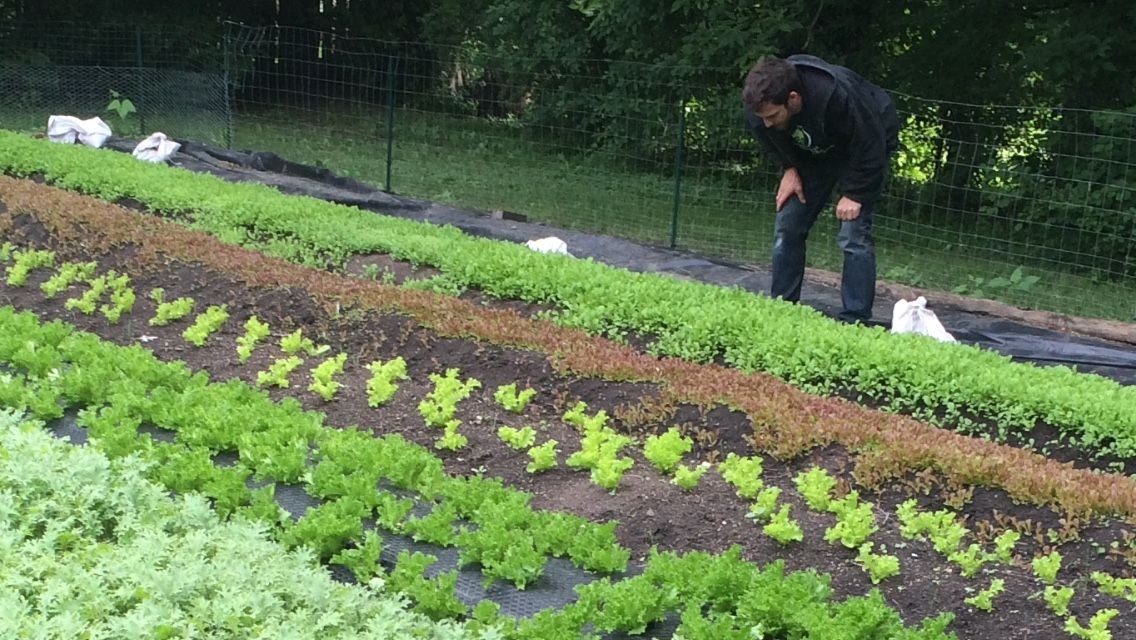Our Story Begins...
About two years ago our van broke down in Iowa. We had been on a road trip across America to work on different farms and learn about sustainable agriculture and by the time this happened our funds were pretty much depleted. So we drove back to Chicago where I'm from and decided to make a go to it in the big city. Easier said than done. Chicago is one of the most expensive places to live. We spent the next year with our heads down working 4-5 jobs between us just to keep our heads above water and in the winter of that year we learned we had a little one on the way.
Now with all this going on, it may have seemed like an inopportune time to start a farm. But my fear was that if I didn't do it now, it might not ever happen. The flame would dwindle and I would get caught up in trying to make money to support my wife and child and it would just become one of those things that you dream about when you're young. It was also around this time that I stumbled upon the work of Jean-Martin Fortier and Curtis Stone. I started to see there was a way to make money farming on a small-scale, if you focused on certain high-value crops.
It was that Spring that I decided to ask my grandma if I could till up her backyard and plant a garden. She was kind enough to say yes and I jumped in head first. Now I should mention at this time I had never really grown anything. Some microgreens in our spare bedroom and working on other people's farms was the extent of my experience. I was literally basing all my farming knowledge off of YouTube, podcasts, and books. I also had a full-time job and would have to make this work in the little free time that I had.
My grandma lives just outside the city on a 1/4 acre lot. I flagged out a 30x100' section and broke ground using an old Troy-Built tiller that she had in her garage. Using a rake I made sixteen raised beds that were each 50ft long by 30" wide. I tarped the lot for a few weeks and after the last frost I began peeling it back two beds at a time, flame-weeding, and hand-scattering seeds. A few weeks later, lo and behold, I had my first crop! Two beds of beautiful arugula. Now I just had to find a way to sell it!
I made up some business cards, a price sheet, and about 20 samples in a cooler and set out upon the city. I hit every restaurant I thought might buy and eventually found myself downtown soliciting five star restaurants. At first I thought, 'This is kinda crazy, I mean, I just grew this in my grandma's backyard.' But soon I realized they didn't know that, nor did they need to. All these chefs saw was this young hustler with a bag a some kick-ass greens. The samples seemed well-received and out of those sixteen or so bags I handed out, I got one chef to say yes.
This was the start. Just one person to believe and from there I was able to land a few more chefs in my hometown and by the time our farmer's market started we were selling everything we could grow. This was all still just a side hustle maybe two days a week and I believe this is KEY. That first year you will make mistakes--heck, every year you will make mistakes, but hopefully by the time that first year is up you will have enough knowledge to avoid the big ones.
Having a stable source of income and doing this on the side is the best option for someone who needs to make an income. Otherwise you will find yourself fretting when that first flush of flea beetles moves in and rips your brassica greens to buckshot. Or downy mildew makes your lettuce spotted and unsightly. Or that week when nobody wants to place an order. Or that five-star chef that stiffs you. The biggest lesson I learned that first year was how to better manage stress. How to make peace with uncertainty and have faith that everything will work out just fine.

So that was last year. Our son was born in late September just as we were wrapping up the season and I was fortunate enough to get a job as a route manager for a snow plow company that winter. By this time we had moved in with my grandma and for the first time since landing in Chicago, were able to save a little money. We began looking for land in North Carolina and creating a plan to take our farm to the next level. We made several investments that have paid huge dividends, such as the Quick-Cut Greens Harvester and the Jang Seeder. Our hope was that we could save up enough to start our farm and have a little bit of money to float us for a while. Unfortunately, mother nature had other plans and we had the first winter in a 146 years without any snow on the ground in January and February.
This did however give us time to make a trip down to North Carolina and scout out some potential properties. We ended up deciding on a 10 acre plot with an old tobacco barn and rustic general store from the 1890's. We settled on a lease arrangement with the owners for $300/month and began brainstorming ways to make this property a thriving, profitable farmstead.
That's all for Part 1. Stay tuned for Part 2: Putting our Plan into Action. Also, check out the video below to take a tour of our farmstead at the 'square one' stage.
Thanks for reading!

